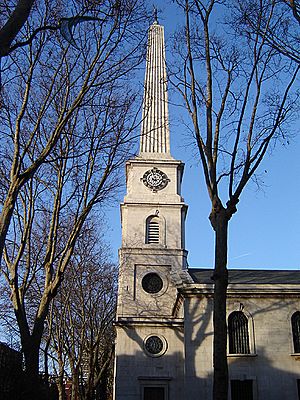St Luke Old Street facts for kids
Quick facts for kids St Luke's Old Street |
|
|---|---|

2006 photo
|
|
| Location | Old Street, London |
| Country | England |
| Denomination | Church of England (Deconsecrated) |
| History | |
| Founded | 1733 |
| Dedication | St Luke |
| Architecture | |
| Functional status | Preserved Used as concert venue by the LSO |
| Architect(s) | John James and Nicholas Hawksmoor |
| Years built | 1727–1733 |
| Closed | 1959 |
| Administration | |
| Diocese | London |
St Luke's is a very old church building in central London, England. It was once a church for the local area from 1733 until 1959. Two famous architects, John James and Nicholas Hawksmoor, designed it. It's considered a very important historical building.
After it closed in 1959, the church was left empty and without a roof for about 40 years. But since 2003, it has become a busy music center. The London Symphony Orchestra (LSO) runs it, and it's now known as LSO St Luke's. It's home to the LSO's special programs that help people learn about music. The main part of the building can hold up to 372 people. The LSO uses it for practice, and many other musicians use it for concerts and recording music. There are also practice rooms in the basement for musicians and community groups.
Contents
History of St Luke's Church
St Luke's Church is located on Old Street, just north of the City of London. It was built to help the nearby church of St Giles-without-Cripplegate because London was growing fast in the 1700s. Construction started in 1727 and finished in 1733. The church was officially opened on October 18, which is St Luke's day.
The architects were John James and Nicholas Hawksmoor. John James likely designed the main part of the church. Nicholas Hawksmoor probably designed the tall tower at the west end and the unique obelisk-shaped spire. This spire had a very unusual weather vane on top. It looked like a dragon's head with a fiery tail. People in the area sometimes joked that it looked like a "louse," which led to the church being nicknamed "lousy St Luke's."
The church was built on ground that was often wet, near an area called Moorfields which used to be marshy. Because of this, the church started to sink over time, especially in the 1900s. You can still see the effects of this sinking in the windows on the north side of the building, which look a bit crooked.
People Buried at St Luke's
Some notable people were buried in the churchyard:
- Mark Catesby (1683–1749), a naturalist who studied plants and animals. His grave is no longer visible.
- William Caslon the elder (1692/1693–1766), who created many famous typefaces (fonts) for printing. His son, William Caslon II (1720–1778), and other family members were also buried here. Their grave is still marked by a special stone tomb.
- George Dance the Elder (1695–1768), an architect. His grave is also lost.
In 2000, before the church became a music center, the basement area was cleared. Over 1,000 burials were carefully moved and reburied at Brookwood Cemetery in Surrey. A TV show called "Changing Tombs" (2001) showed how this process was done.
From Church to Music Venue
In 1959, St Luke's Church had to close because of the sinking ground and fewer people living in the city center. The church's important items, like the font and organ, were moved to other churches. The roof was taken off for safety. For about 40 years, St Luke's was an empty shell, even though it was a protected historic building. Trees even started to grow inside!
After some discussions about what to do with the building, it was decided to turn it into a music center for the London Symphony Orchestra. The architects, Levitt Bernstein, designed the new space. They added a heavy concrete roof to keep out noise from the nearby road. This new roof looks similar to the old one, but it's supported by strong steel columns inside the hall. The inside of the hall can be changed to sound different for various types of music, from a full orchestra to a single performer. The seating can also be moved around. The work was finished in 2002, and the center opened in early 2003.
Special Events and Performances
LSO St Luke's often hosts open rehearsals by the London Symphony Orchestra before their big concerts at the nearby Barbican Hall. It also holds unique events that mix different music styles, like classical, jazz, and electronic music.
Students from Junior Trinity have also performed here as part of their concerts.
Many famous musicians have performed and recorded at St Luke's:
- In 2006, the BBC recorded concerts by Bruce Springsteen and Paul Simon.
- In October 2006, Sting performed songs by John Dowland. This concert was later released as a CD/DVD.
- Sir Elton John recorded a concert here to promote his album The Captain & the Kid.
- MTV recorded a concert by Editors in 2007.
- Patti Smith, Philip Glass, and Lenny Kaye performed a tribute to Allen Ginsberg in 2007.
- Van Morrison recorded a concert for BBC Four Sessions on April 25, 2008.
- In September 2008, Duffy played for BBC Sessions, which was shown on TV in October 2008.
- In December 2008, BBC Four showed Sacred Music: The Story of Allegri's Miserere, which included a performance by The Sixteen at St Luke's.





